Flaky Lard and Butter Pie Crust (Foolproof Recipe)
Make the best lard and butter pie crust with this foolproof recipe! Using high-quality leaf lard, cold butter, and an egg-vinegar mix, this homemade pie crust is tender, flaky, and buttery—perfect for any pie. It’s a must-try for pie lovers!
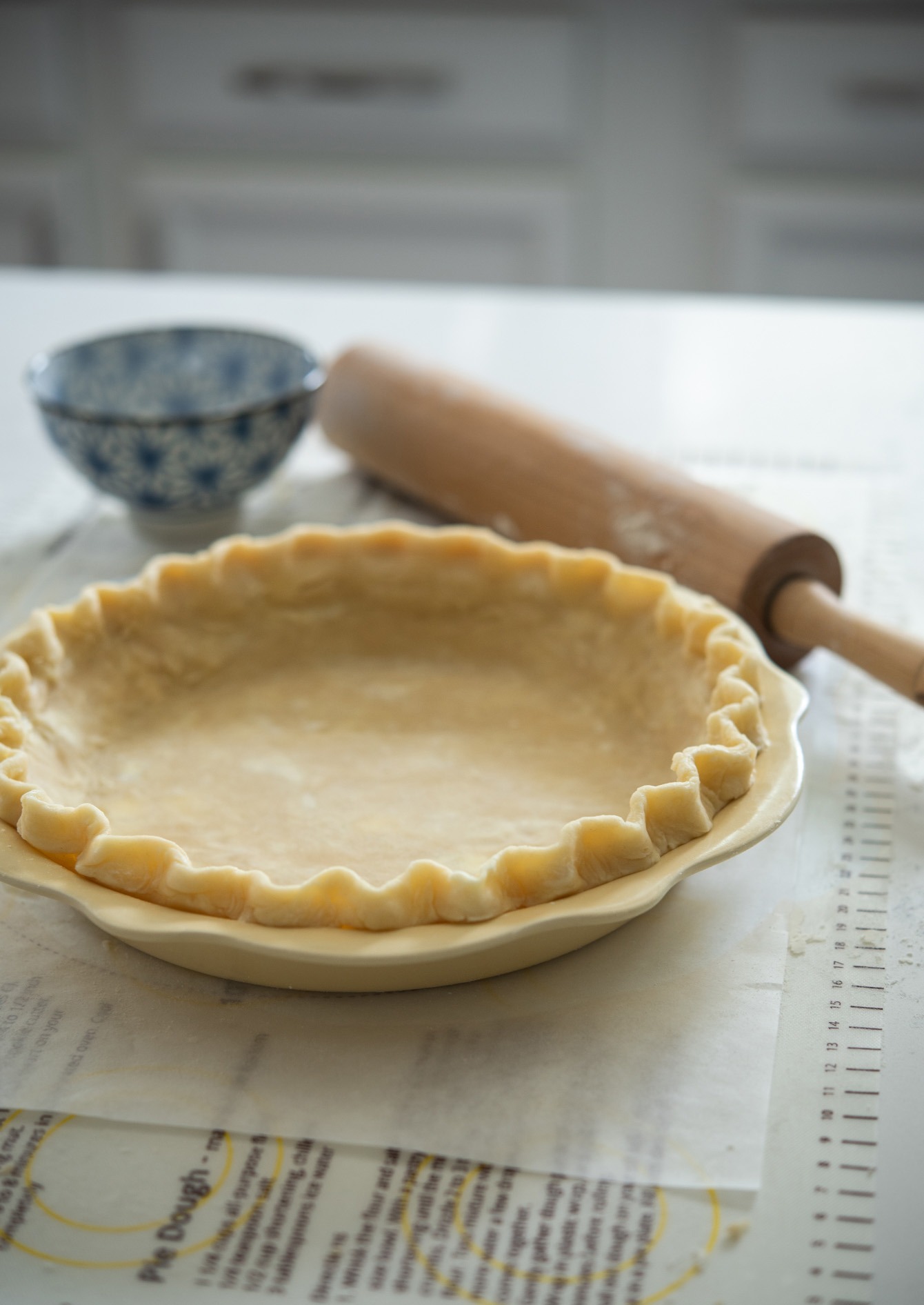
A truly great pie starts with the perfect pie crust. For me, that means dough that rolls out easily, holds its shape in the oven, and tastes as good as the filling it carries.
After years of testing every type of pie crust—butter, shortening, even oil—I landed on this lard and butter version as my forever recipe. Leaf lard creates unmatched flakiness, butter adds rich flavor, and together they bake into a crust sturdy enough for juicy fillings yet tender enough to melt in your mouth.
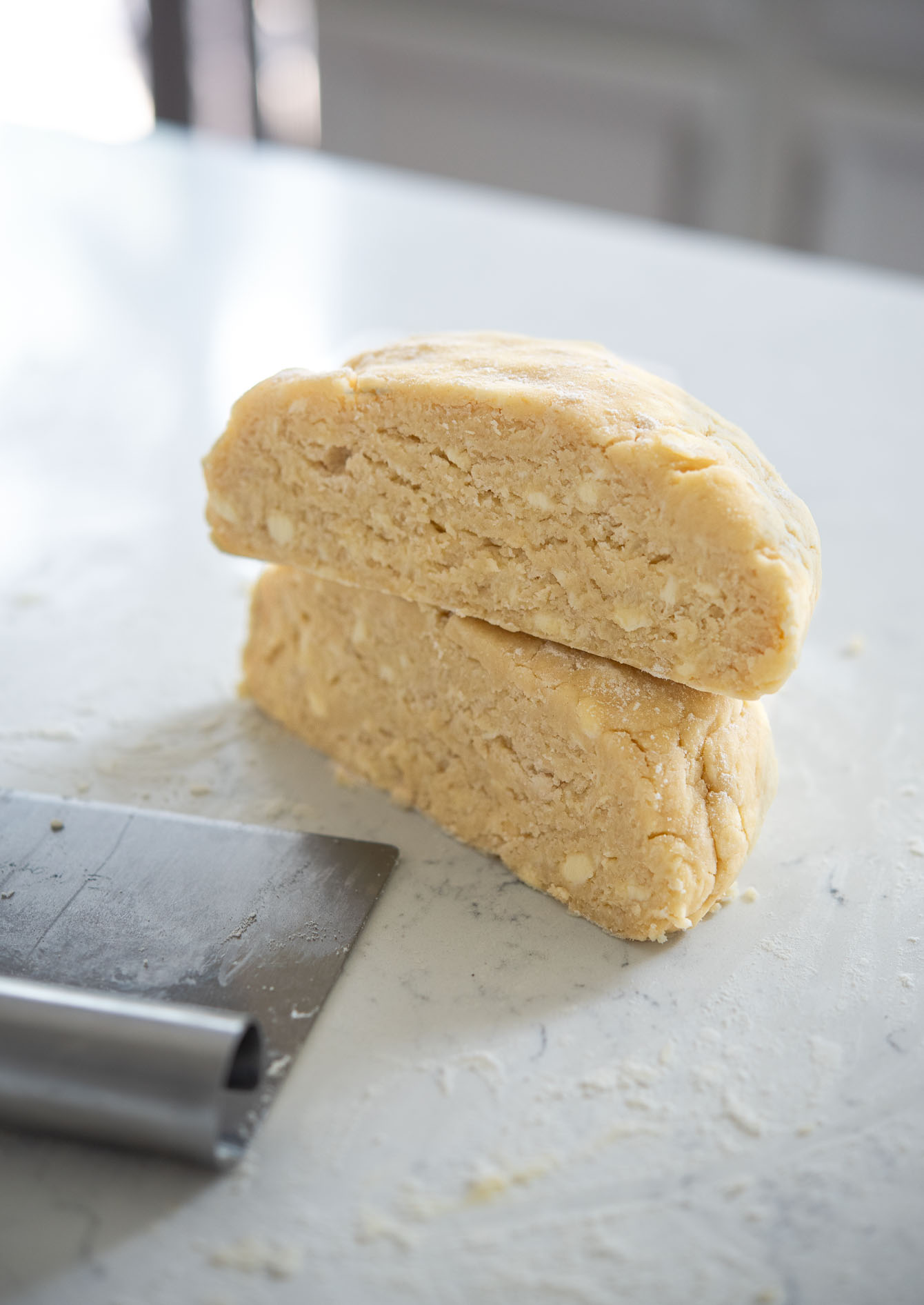
I use this crust recipe for all my pies every Thanksgiving, and my family love it year after year. Once you taste it, you’ll see why I never go back to an all-butter or butter-shortening crust.
What is Leaf Lard (and Why It Matters)
Leaf lard is the highest-quality pork fat, taken from around the pig’s kidneys. Unlike regular lard, it has a neutral flavor and a silky texture that makes pastries extra tender and flaky. That’s why bakers prize it for pies.
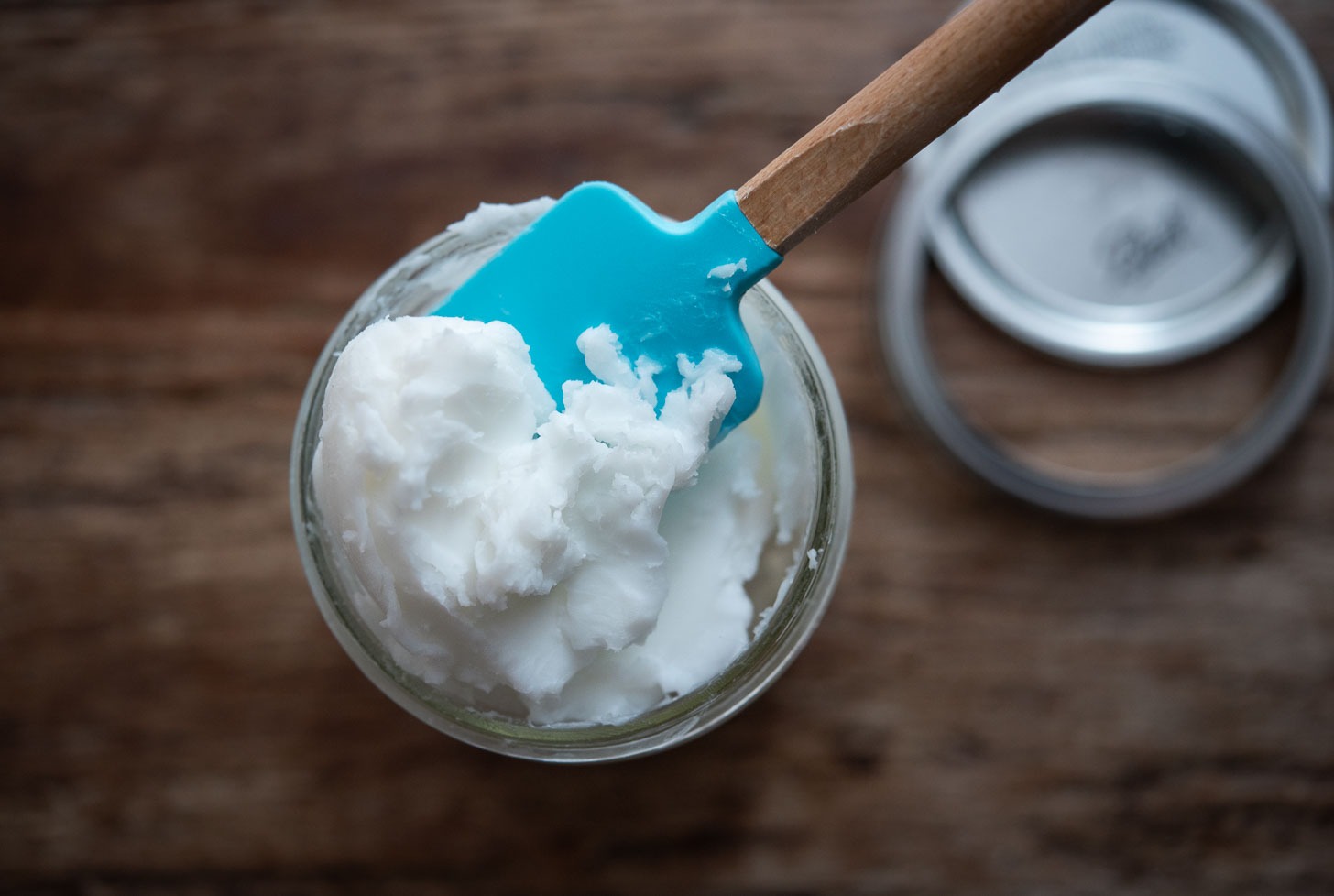
I didn’t fully understand the difference until I tested side by side: my all-butter crust tasted good, but the leaf lard version baked up lighter and held its shape better. For juicy pies like blueberry or peach, that’s a game-changer.
You can usually find bottled leaf lard at butcher shops or farmers markets, and some specialty stores online. I often buy mine from Fannie & Flo, and it stores well in the freezer so you’re always ready to bake.
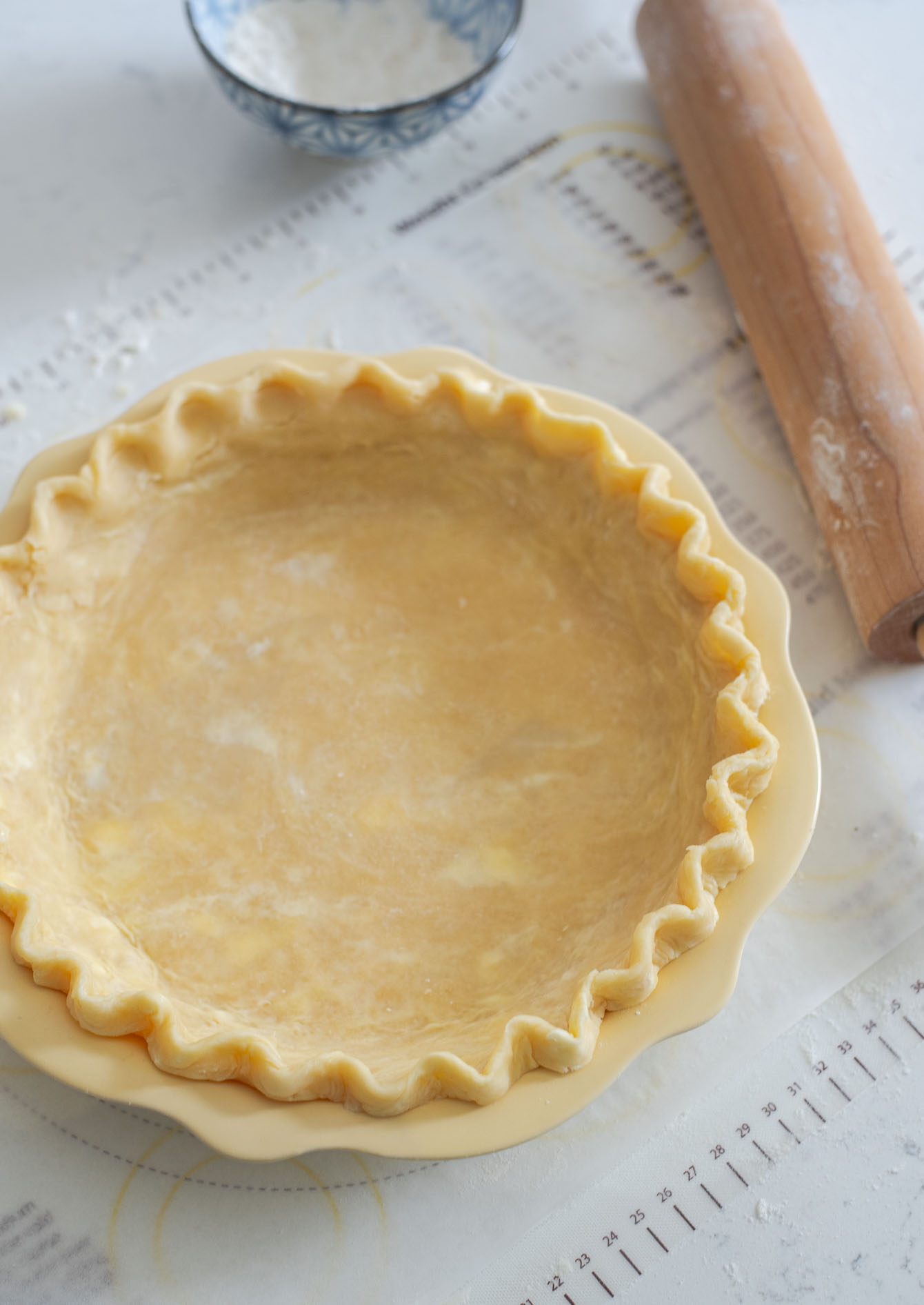
Ingredients That Make This Crust Foolproof
Over the years, I’ve tweaked this recipe through dozens of pie trials, and these ingredients—and the way they work together—make the difference between a good crust and a truly flaky one.
- All-purpose flour + a touch of cornstarch: The cornstarch isn’t traditional, but I use it to lighten the texture. It’s my trick for keeping the crust tender without sacrificing structure.
- Leaf lard + butter: Lard creates visible flaky layers, while butter adds flavor. I tested butter-only crusts that tasted good but fell flat on flakiness, and shortening crusts that were flaky but bland. This half-and-half balance is the winner.
- Egg + vinegar: This is the old-school baker’s secret I learned from an old pie cookbook. The egg makes the dough easier to handle, and vinegar keeps gluten from toughening the crust. Without them, the dough can shrink or crack more easily.
- Ice water: The temperature matters just as much as the water itself. Ice cold water keeps the fat from melting into the flour too soon, which is the difference between a dense crust and one that puffs into layers.
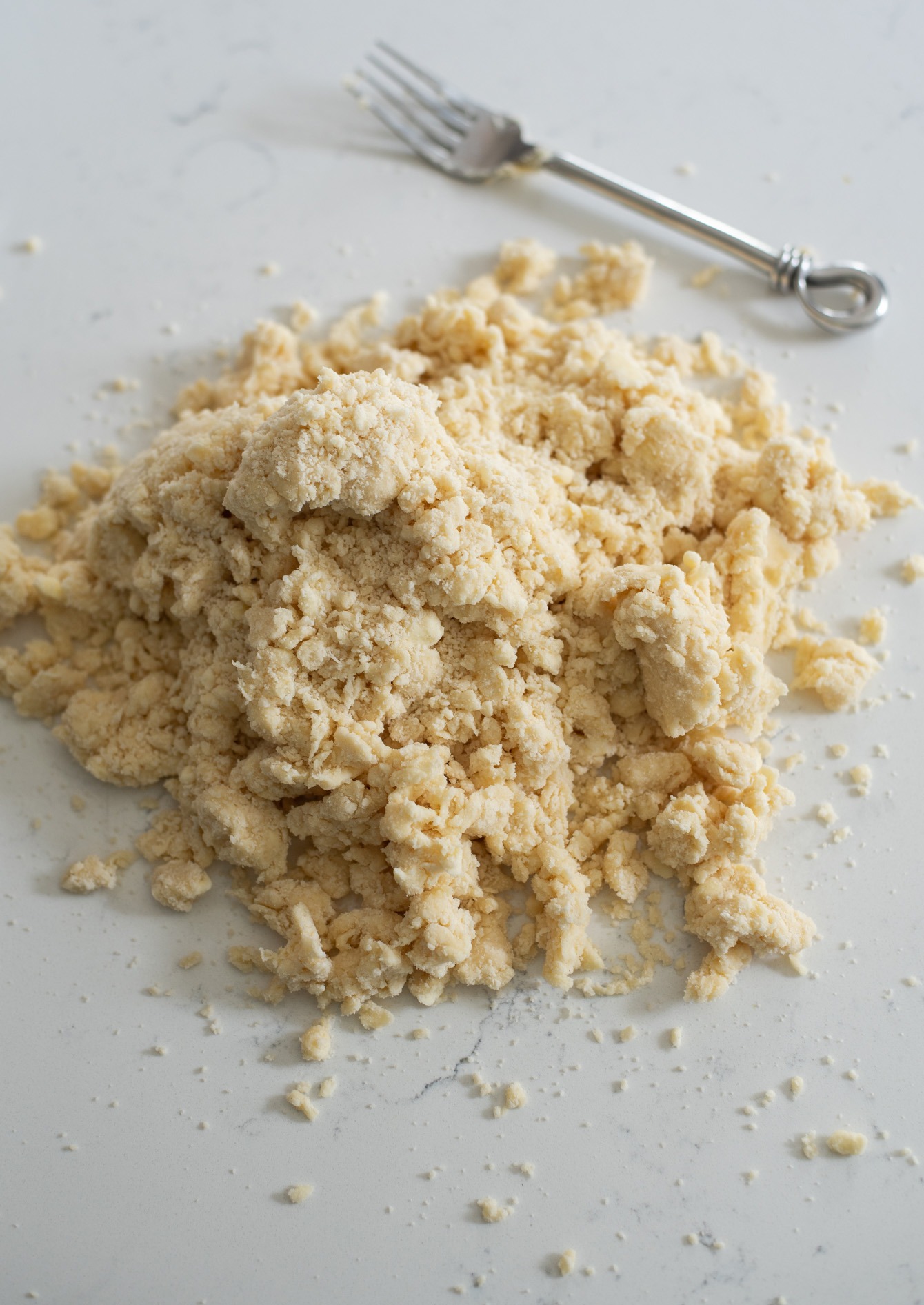
Step-by-Step Visual Guide: Lard & Butter Pie Crust
I’ve included detailed photos here so you can see what each stage of the dough should look like. The recipe card below has all the exact measurements, but these visuals (and my notes from years of testing) will help you get it right the first time.
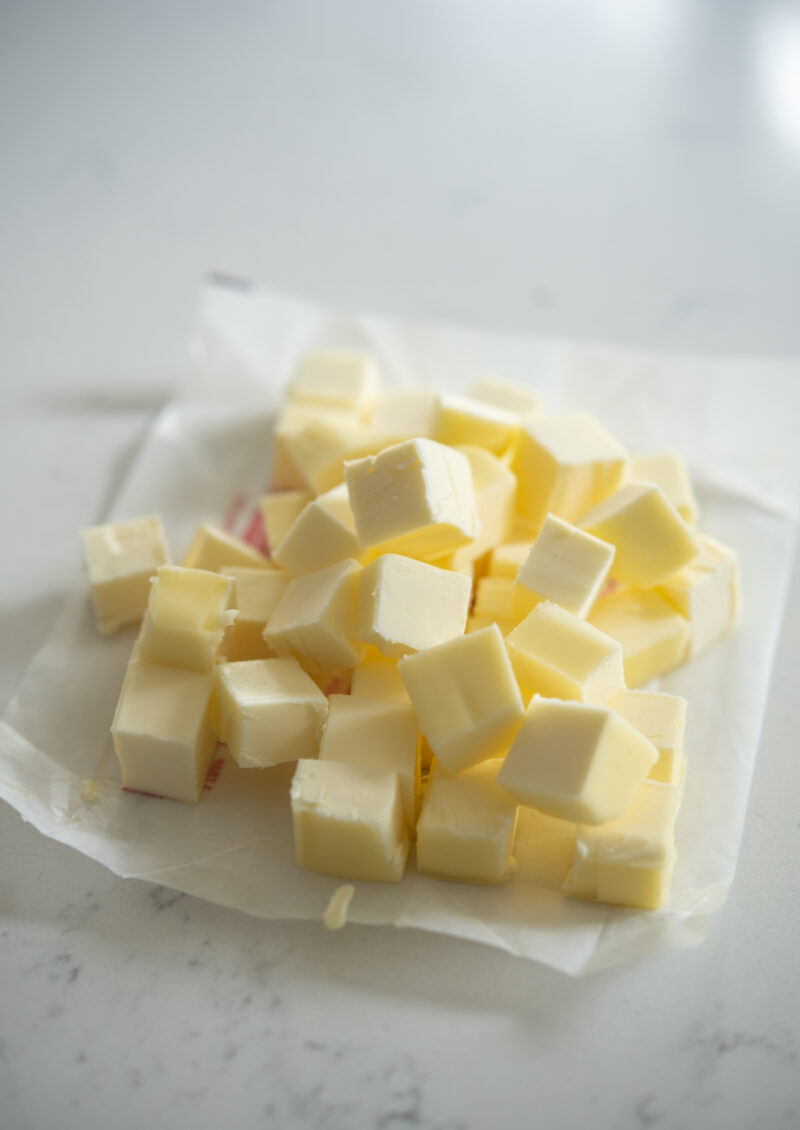
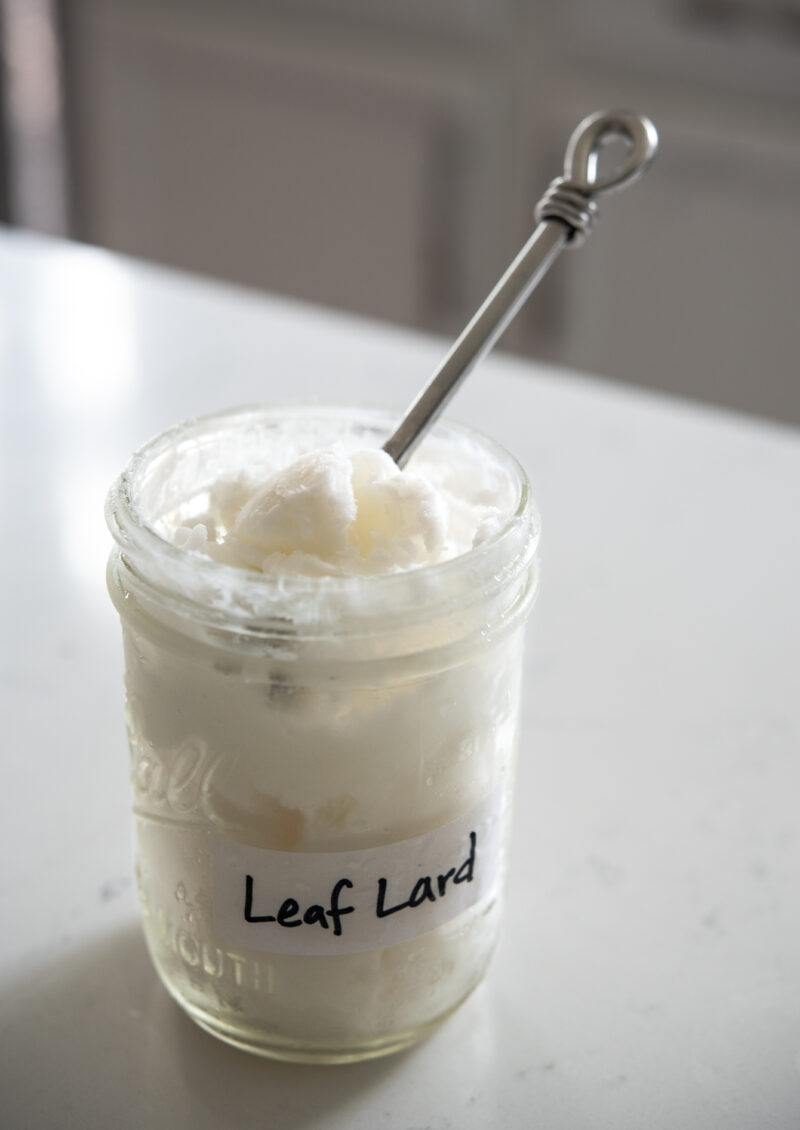
Cold fat is non-negotiable. I cut the butter into cubes and keep them in the freezer for 10 minutes while I scoop out the leaf lard. If the fats soften, the crust won’t flake properly.
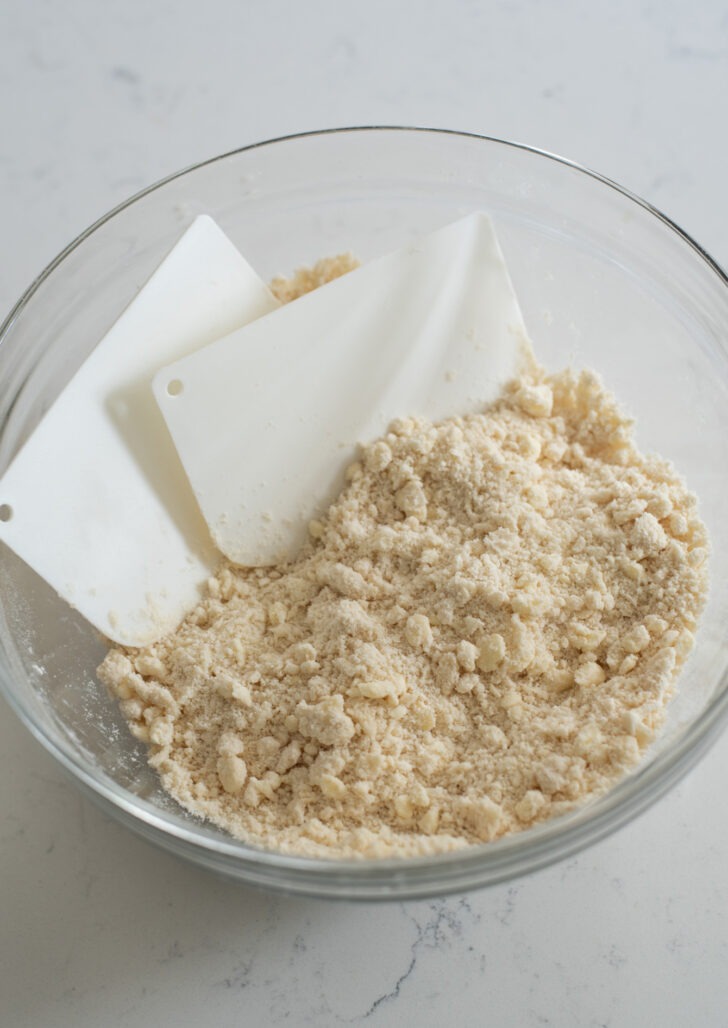
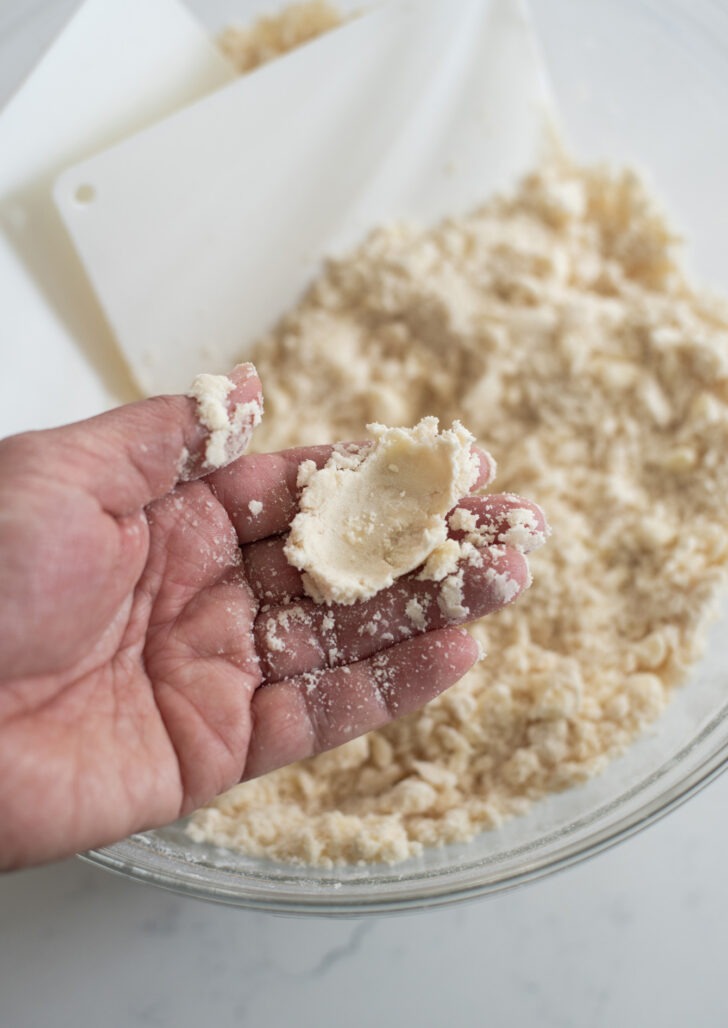
Cut in the fat. The flour should coat the butter and lard, leaving pea-sized chunks. If you blend until it looks like sand, you’ve gone too far. Those visible fat pieces are what puff into layers in the oven.
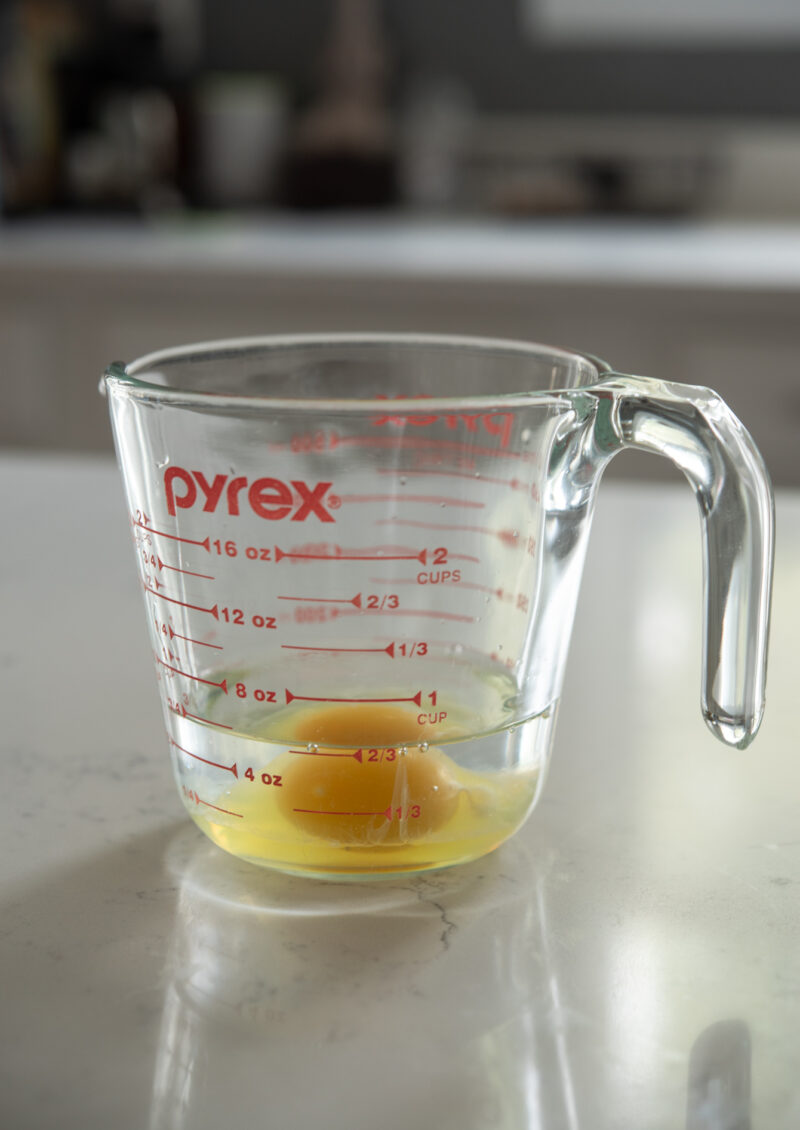
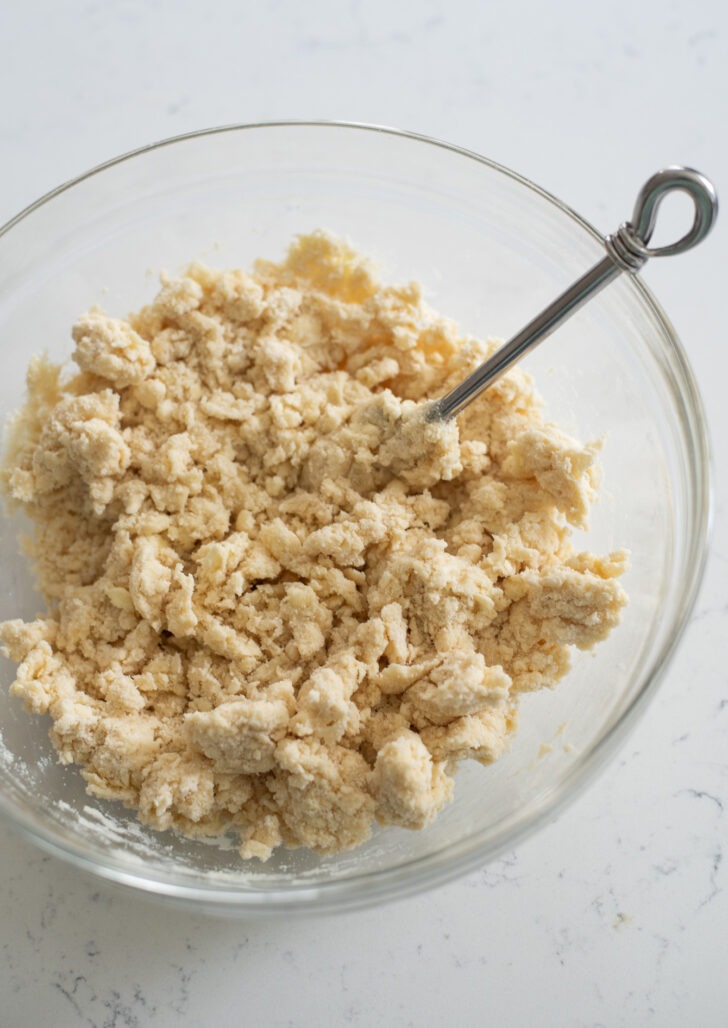
Add the egg-vinegar mix gradually—start with half, then drizzle more only where the flour looks dry. The dough should just hold together when pinched, not sticky and not crumbly. This is where many bakers over-hydrate, so go lighter than you think.
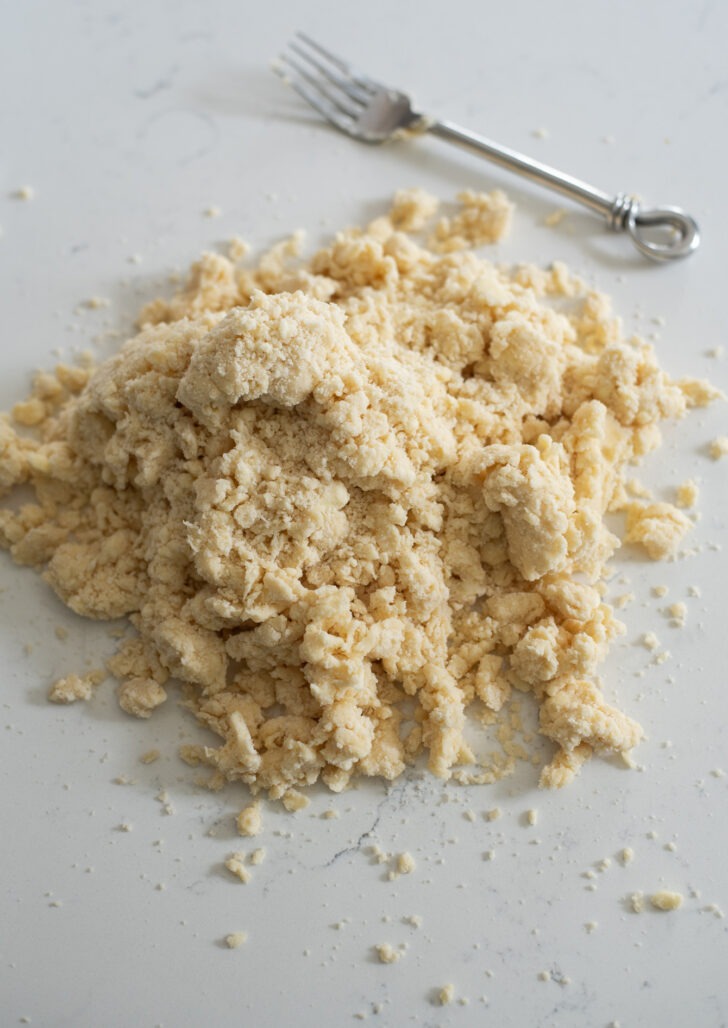
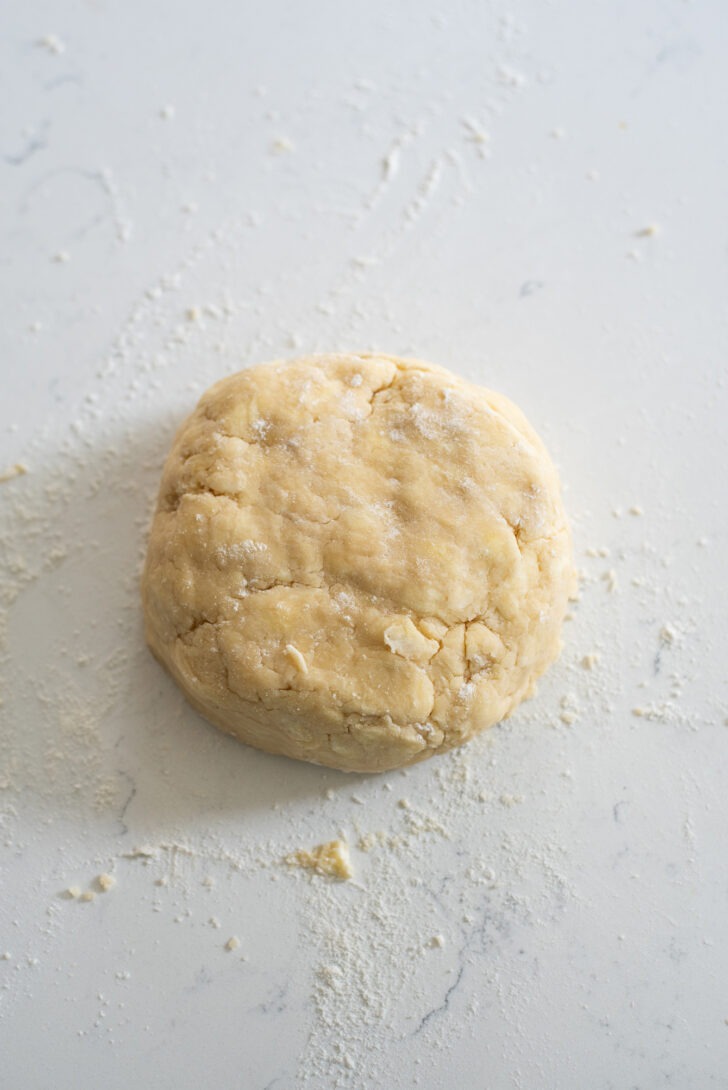
Gather, shape, and press the dough together gently—never knead.
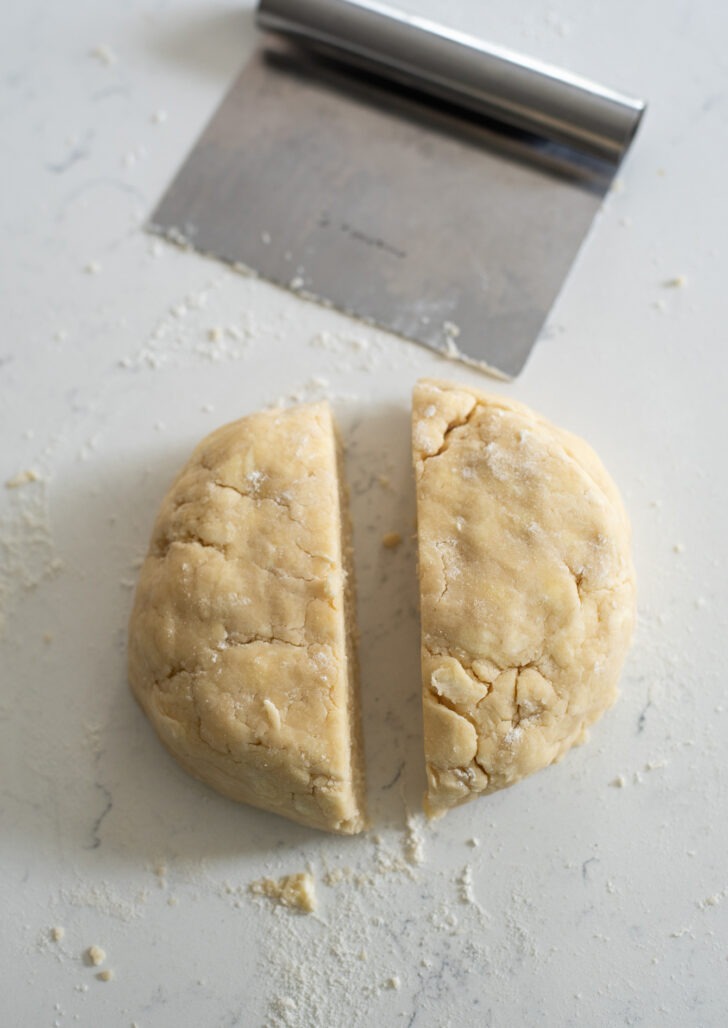
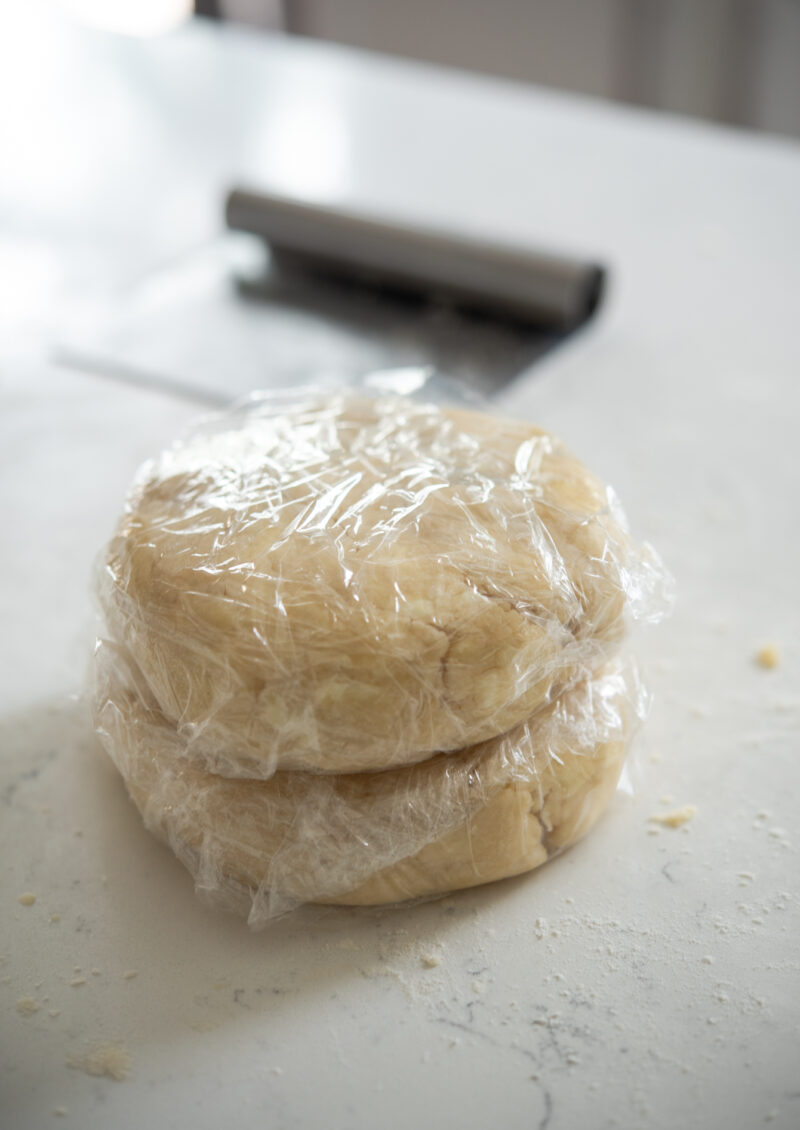
I divide it into two disks and chill them for at least an hour. Resting relaxes the gluten and keeps the crust tender.
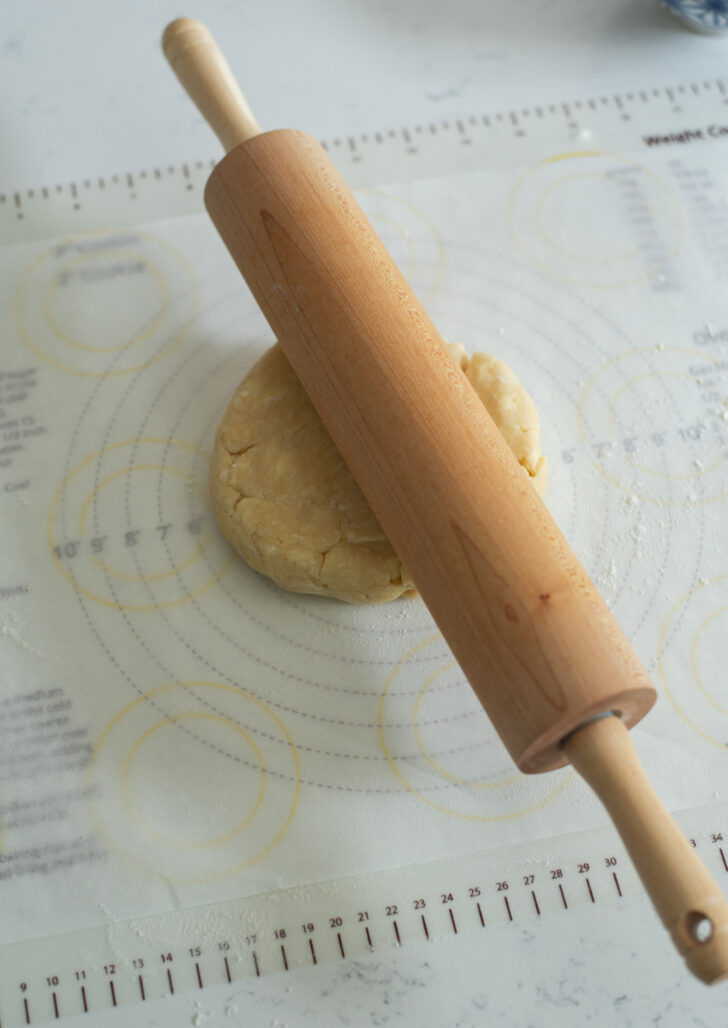
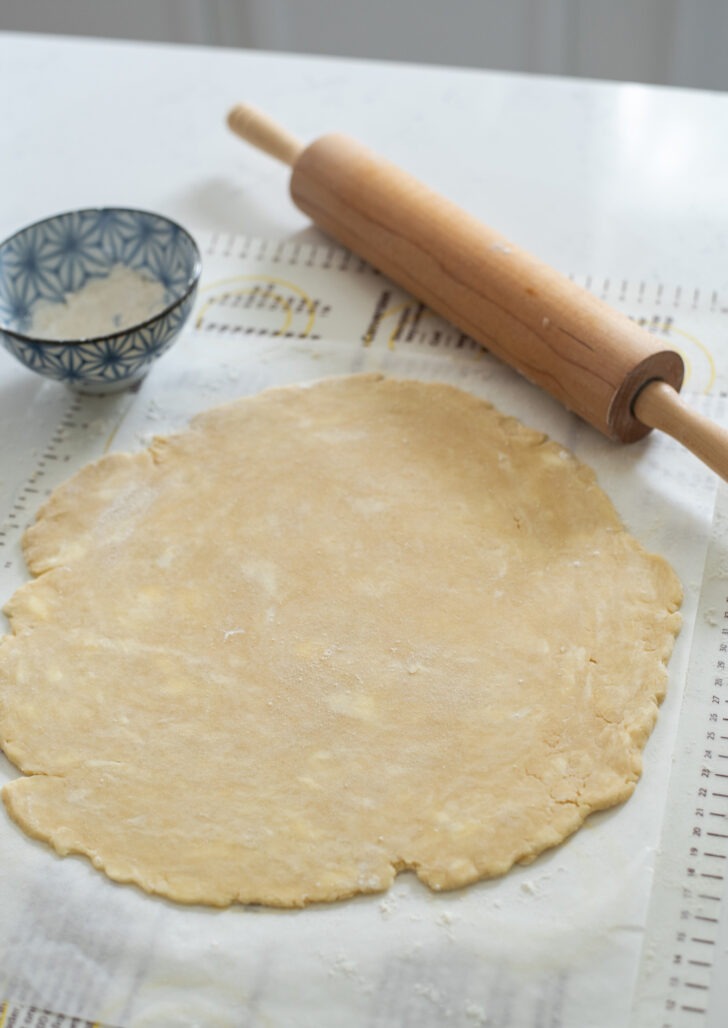
I give the dough a couple of firm taps with my rolling pin to loosen it up. Roll from the center outward, turning the dough often to prevent sticking. Aim for about 13 inches across for a standard 9 pie pan.
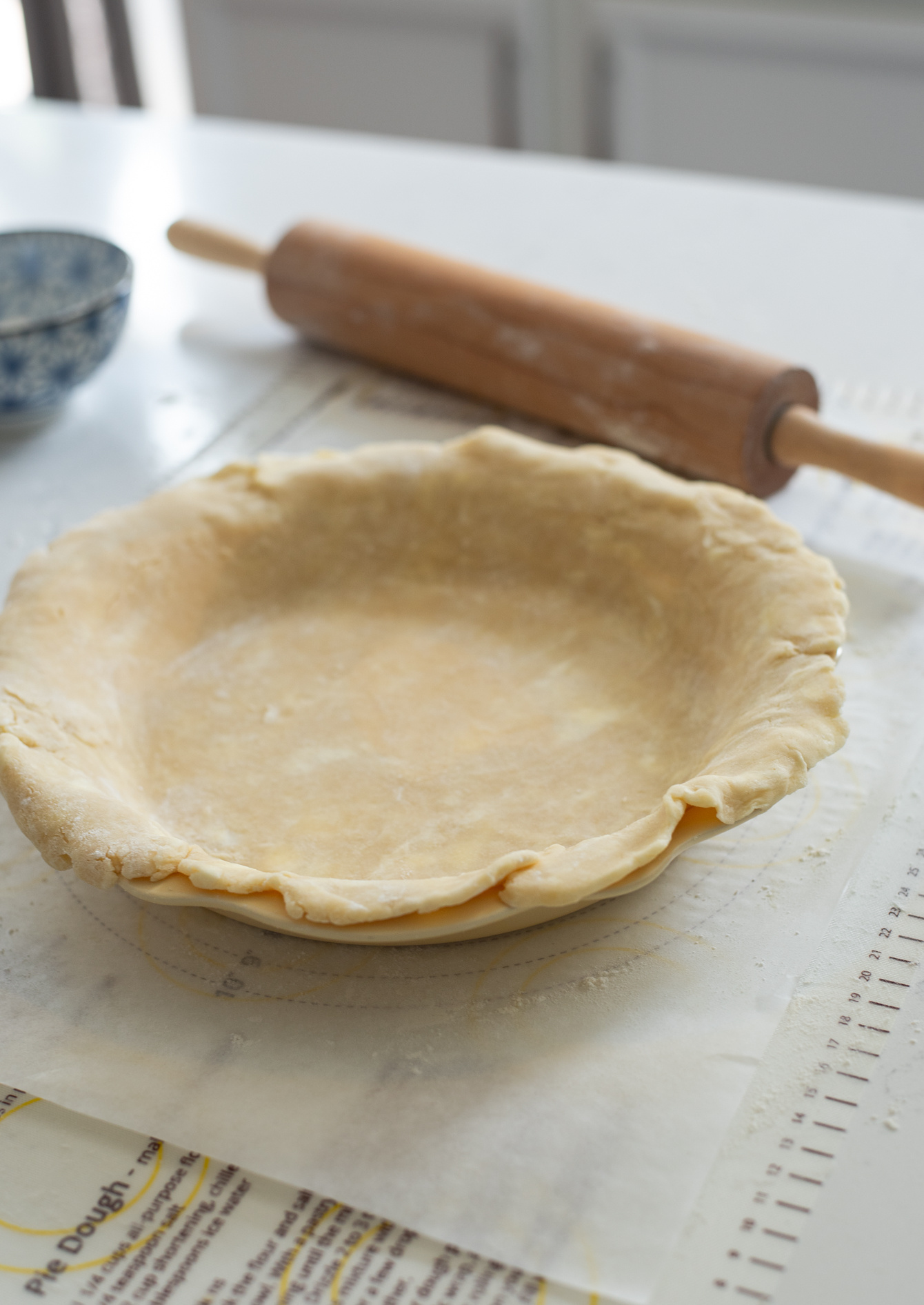
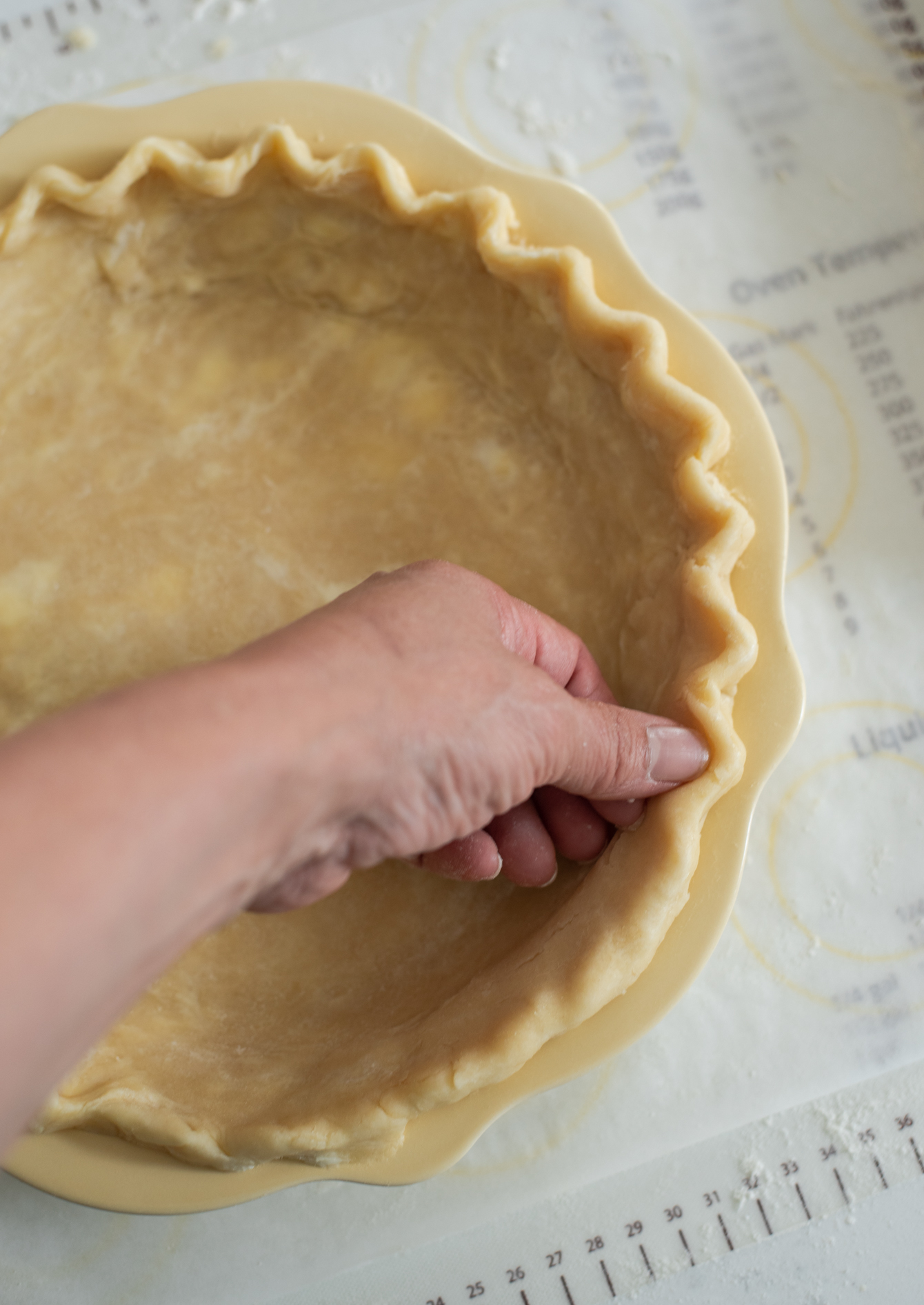
Tuck the excess dough under itself, then pinch between thumb and forefinger for a neat V pattern. A well-fluted edge isn’t just pretty—it helps the crust hold shape during baking.
Prefer to use a food processor? Check the recipe notes below for a quicker method.
Watch Recipe Tutorial Video (Full Version)
How to Par-Bake (Blind Bake) This Crust
Some pies (like custard or cream pies) need a crust that’s fully baked before you add the filling. That’s when par-baking, or blind baking, comes in.
To do it, line the chilled crust with foil or parchment, fill with pie weights (I often use dried beans I keep just for this), and bake at 375°F for about 10–12 minutes. Remove the weights and let the crust cool before adding your filling.
Tip from my kitchen: with this lard-butter crust, I like to chill the dough again after fluting the edges, then blind bake—this helps the fluted shape hold beautifully in the oven.
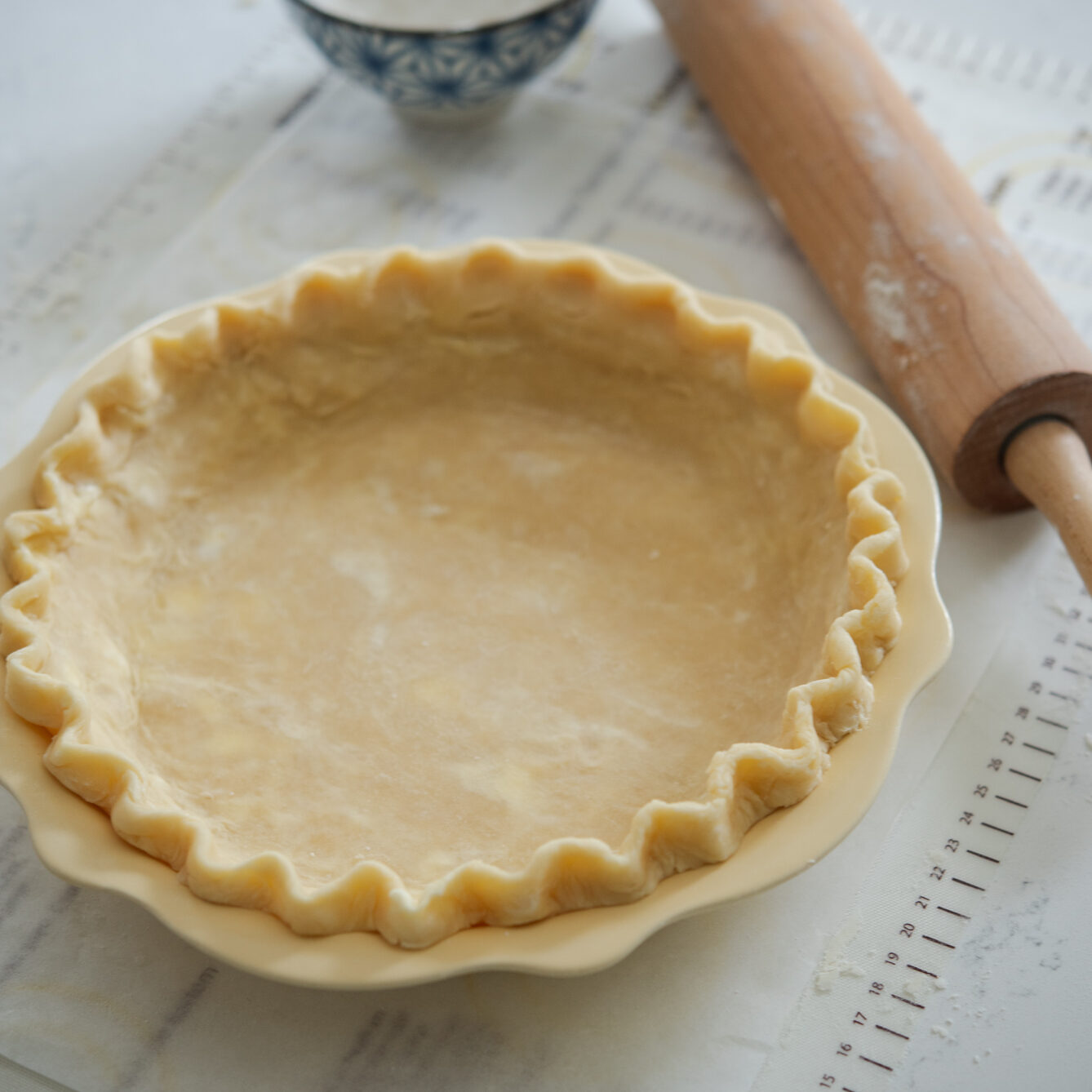
Make-Ahead Pie Dough: Storage & Freezing Guide
Pie dough is one of the best things to make ahead—once it’s ready, you’re halfway to a homemade pie. Here’s how I store it so the texture stays flaky:
- For unbaked dough: Wrap each disk tightly in plastic, then slide them into a freezer bag. Dough keeps in the fridge for up to 1 week or the freezer for 3 months. Thaw overnight in the fridge before rolling.
- For shaped pie crusts: You can roll out the dough, fit it in the pan, and freeze the whole thing (pan and all). I do this around the holidays so I can just pull out a crust, fill, and bake. If baking from frozen, give it a few extra minutes.
- Pro tip: always label your dough with the date—I’ve pulled mystery dough from my freezer too many times to skip this step now.
Pies Made with This Crust
Here are a couple of examples of pies made with our lard and butter pie crust—all-American deep dish apple pie and maple blueberry pie.
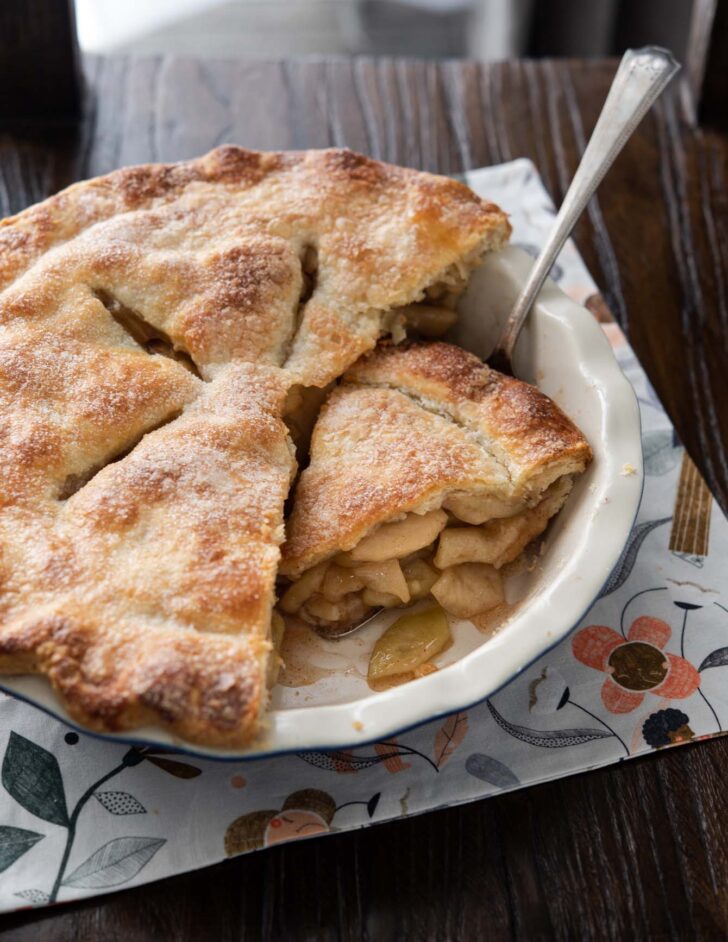
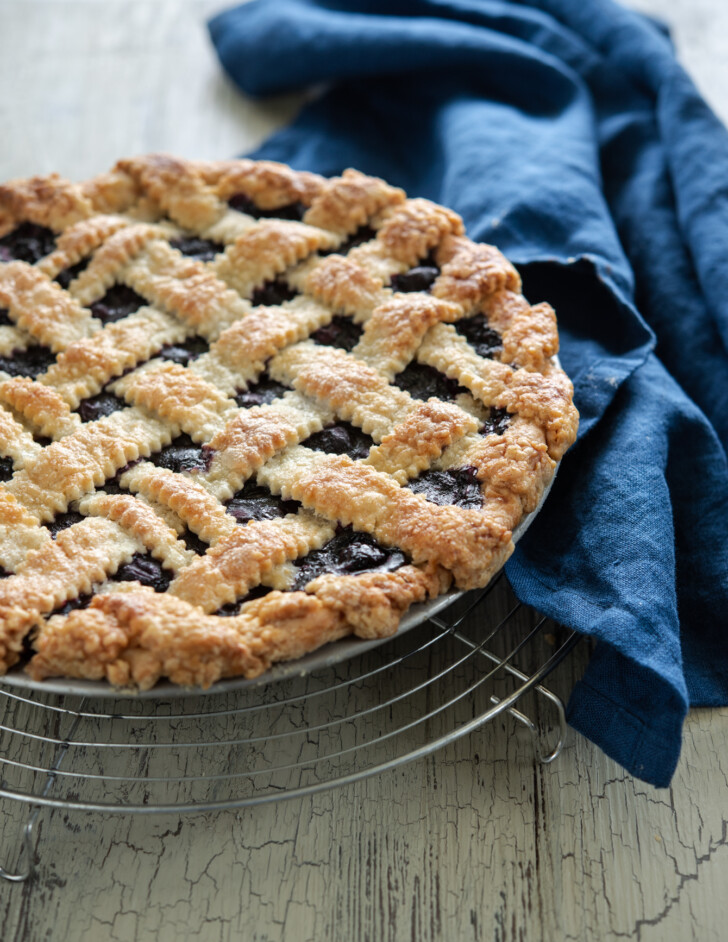
As you can see, this crust bakes up beautifully golden, light, and flaky, enhancing both the appearance and flavor of any pie. I hope you can give one of these fabulous pies a try. It won’t disappoint you.
Love this recipe? Rate it and share your experience in the comments below! On Instagram? Tag me to showcase your creation. For more delicious recipes, subscribe to our newsletter!
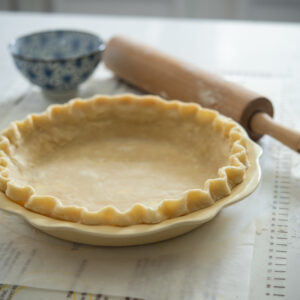
Flaky Lard and Butter Pie Crust (Foolproof Recipe)
Recipe Video
Ingredients
- 3 cup (370 g) all-purpose flour
- 1 tbsp (7.5 g) cornstarch
- 1 tsp (5 g) salt
- 10 tbsp (128 g) leaf lard , or lard, chilled
- 8 tbsp (113 g) butter, chilled and cut into small cubes
- 1 large egg
- 1 tbsp (15 ml) white vinegar
- ice cold water
Equipment
Instructions
- Mix Dry Ingredients: Whisk together flour, cornstarch, salt in a large mixing bow. Add the leaf lard by the tablespoonful and butter cubes.
- Cut in the Fat: Add the leaf lard by the tablespoonful and butter cubes. Cut the fats into the flour using pastry blender or scrapers until coarse crumbs form. The mixture should hold shape when lightly pressed.
- Make Egg-Vinegar Mixture: Crack an egg in a glass measuring cup (2 cup, about 480 ml, size), and add vinegar. Pour cold water to measure the liquid to reach 2/3 cup (158 ml) amount. Beat the mixture well.
- Add Liquid to Dry Mixture: Drizzle about 1/2 cup (120 ml) of liquid around the crumb mixture and stir gently with a fork. Add more liquid only to dry spots until the dough is moistened (not sticky). Some crumbs are okay.
- Gather and Chill Dough: When the dough mixture is moistened without being too sticky or dry, dump it on a lightly floured surface. Gather up the dough. Divide the dough in half. (If I am making a double crust pie, I usually make the bottom crust dough to be slightly larger than the top crust portion) Shape into disks, wrap in plastic, and chill for at least 1 hour.
- Roll Out the Dough: If the chilled dough feels too firm, give it a few firm taps with the rolling pin to loosen. Lightly flour your work surface and rolling pin. Roll the dough from the center outward, turning it a quarter turn after each roll to keep it even. Aim for a 13-inch (33 cm) circle. Slide your fingers under the dough occasionally to prevent sticking, dusting with a touch more flour only if needed.
- Flute the Edges: Transfer the pastry to fit into a pan, gently nudging it down the sides of the pan. Lift up the overhanging dough and fold it under. Create the flute by using your thumb and forefinger to make a V pattern. Cover with plastic and refrigerate until ready to use.
Notes
- Keep everything cold—freeze butter cubes for 10 minutes before using.
- Add liquid gradually; a slightly dry dough bakes flakier than an over-hydrated one.
- Always chill the shaped crust before baking; it helps the edges hold their shape.
- Use a glass pie pan if possible—you can see the bottom browning for perfect doneness.

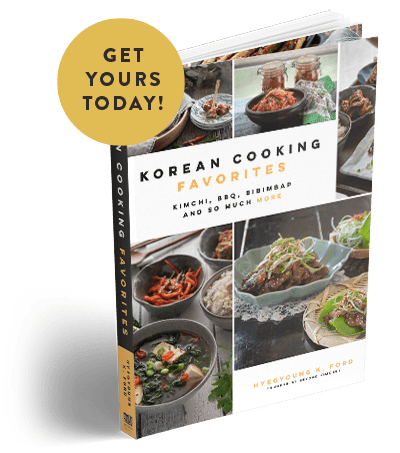
Can I make the dough a day earlier and keep in refrigerator until the next day when I’m ready to cut and peel my apples?
Absolutely! You can make the dough a day ahead.
Just wrap it very well (plastic wrap, then a zip bag) so the surface doesn’t dry out. It will firm up in the fridge, so before rolling, let it sit at room temp for 5–10 minutes to loosen slightly. Give it a few taps with the rolling pin and it’ll roll out beautifully. Good luck!
Hi Holly,
Can I do this in food processor. I’ve made straight lard pie dough that way. Will it work for butter and lard?
Thank you
Sandi
Yes, you can make it in a food processor! I’ve included the method in the recipe card notes. Other readers have tried it this way and had great results. Hope you enjoy this crust, it’s truly my favorite!
IS THIS RIGHT? I followed the recipe to the letter. Great rollout and it felt wonderful…a bit of cracking in the usual places, but perfect dough in every respect.
Now it’s in the oven and it appears to be disappearing right before my eyes! When I put the pie in the oven I could not see any shapes of blueberries under the top crust, but after 15 minutes in the oven, it’s a load of lumps! I’ve never had a crust do this before, ever! What could be going on here? I really wanted to post a photo of a beautiful pie, but I had to post this question.
Hmm, I’m sorry to hear that your crust didn’t turn out as expected. I’m not entirely sure what you mean by the crust turning into a load of lumps while baking in the oven. Did you happen to use a solid top crust without adding any vents for the steam to escape? If you can share a picture or describe how you assembled your pie, I’d be happy to help troubleshoot further!
I think I made the top crust too thin. You can delete this post and give me space to comment when I make a beautiful crust from this recipe. It tasted great, it just didn’t look very good:)
PHENOMINAL! I love that you chose to also add the weight of the ingredients as well, which made putting the crust together quick and easy. I used your food processor method which was similarly quick. BTW, I purchased a soft and delicate leaf lard without a porky flavor from fatworks.com. (Interestingly, I recently read that leaf lard has less saturated fat than butter) I used your maple blueberry pie recipe from the website as well, substituting a triple mixture of frozen berries (blueberry, blackberry, and raspberry) but leaving everything else the same. I have finally found a berry pie recipe that is not runny! I’m so glad I discovered your site. These are both definitely keeper recipes. Thank you!
Thank you for sharing this recipe!! I was intrigued by the use of cornstarch in this recipe — I’ve never used that before!! I made this pie crust recipe for the first time today and I have never made flakier more tender pie crust ever!! Thank you for sharing. I do experiment a lot, with different flours, etc, but I will come back to this recipe when I want to be certain it will turn out!!
That’s just wonderful to hear that this pie crust turns out so well for you. Thank you so much for your comment!
My first pie crust ever! My kids and grandkids thought I got the pie from our favorite pie makers in Long Island, NY.
Thanks Holly for this amazing pie crust recipe. I used processor method. It’s flaky, light and super flavorful!!
Hi Susan
I’m so thrilled to hear that your first pie crust turned out so well with this recipe. It made my day! Thank you so much.
I am good baker, but pie crusts are my Achilles heel. This was my first pass at making a crust with lard, and this recipe didn’t fail. I made the double crust even though I only needed one, so I had some dough left that I made into four mini butterscotch tarts in ramikins. The crust is absolutely perfect. Tomorrow is the trust test when I make my pecan pie in the shell that I have read. Thank you for the perfect pie crust recipe! It’s a keeper. (Note, I haven’t been able to fine Leaf Lard yet, but used a brand called Leidy. Seemed to work out OK.)
So happy to hear that this pie crust recipe worked well for you. I hope your pecan pie turns out perfect! Thank you so much for your comment.
Your recipe looks great but I am unable to find instructions on pre bake and oven temps. Also times and temps for the bake for filled pie. Thanks
Hi Jill
You can find information on how to pre-bake the pie crust in the post content. I’ve also added it to the recipe card. Thanks for the reminder! I hope you get a chance to try this recipe!
Just did your recipe, used it for apple pie and it was very tender and flaky. I didn’t have to use all the liquid. 15 minutes à 425 then 40 à 350 and perfect results, very happy and it goes in me “keep” book 🙂
Can you use leftover crust to form a single pie crust without it being tough.
You can make a small pie crust with the leftovers, but the more you handle the dough, the tougher it will get. So, limit mixing the dough to a minimum to keep it tender.
Hi Holly. I am making a pie crust for the first time ever, so I watched the video as well as read all your notes and comments. I am confused about one thing though. The recipe states 10 tbsp lard and 8 tbsp butter, but the video says the opposite..8 lard and 10 butter. Which should I follow?
Use 8 tbsp of butter and 10 tbsp of lard. I made a mistake in the video, and it was too late to fix it after uploading. I hope you enjoy this pie crust. Thanks!
Thank you so much for this recipe! I’ve been trying to improve my pie crust without using crisco for years. This recipe does the trick.
The crust is great, but I found that it must be baked with weights for 15-20min; then remove beans/weights and return to oven for another 15 or the bottom crust will be under-cooked.
I made lemon meringue and chocolate fudge pudding pies which this crust really compliments.
Can this be made ahead and frozen baked later?
Certainly! You can either freeze the pie dough as is, or roll it out and form it in the pan before freezing. You’ll find the instructions in the post content. Thank you!
Fantastic pastry, thank you! This will be my go to from now on.
Thrilled to know you love this pastry! Enjoy your pie-making journey! Thanks for the comment.
This recipe looks great and I am anxious to try it…can I substitute gluten free flour?
Hi Tamie
I have not tried with gluten free flour but I think it should work. Hope it works out for you. Let me know how it turns out. Thanks.
Hi Holly,
I have a question… I do not eat pork… is there an alternative to lard… would crisco work?
Hi Pocho
You can use vegetable shortening instead of pork lard. That’s is perfectly fine. Hope you like this recipe. Thank you.
Hi Holly! I’m so glad I found your amazing pie crust recipe. I made it last night. It is truly the best I’ve ever made or eaten. Excellent! I’m going to make a few and freeze them. Can’t wait to check out your other recipes. 🙂
Hi Sherrie
Thanks for visiting my site. I am so glad that you loved my pie crust recipe. Hope you get to find more delicious recipes in my site to try. Don’t hesitate to ask if you have any questions.
Thank you!
Have yet to make but sounds good.. What about baking instruction pre-cooked crust being added to the recipe please?
Hi Corinne
I added a tip on how to par-bake (blind bake) the pie crust in the post. Hope it helps. Thanks.
This recipe is awesome! I have always made Pioneer Woman’s pie crust and they don’t compare. This recipe is definitely more flaky and the tasty. My husband and dad loved the crust! This will be my pie crust recipe I will use forever. Thanks for sharing it.
Loved this recipe.! It made enough for 3 pie crust. It was easy to roll out and it created a flaky crust. Highly recommend.
We love the combo of lard and butter in pie crusts. This looks great — thanks.